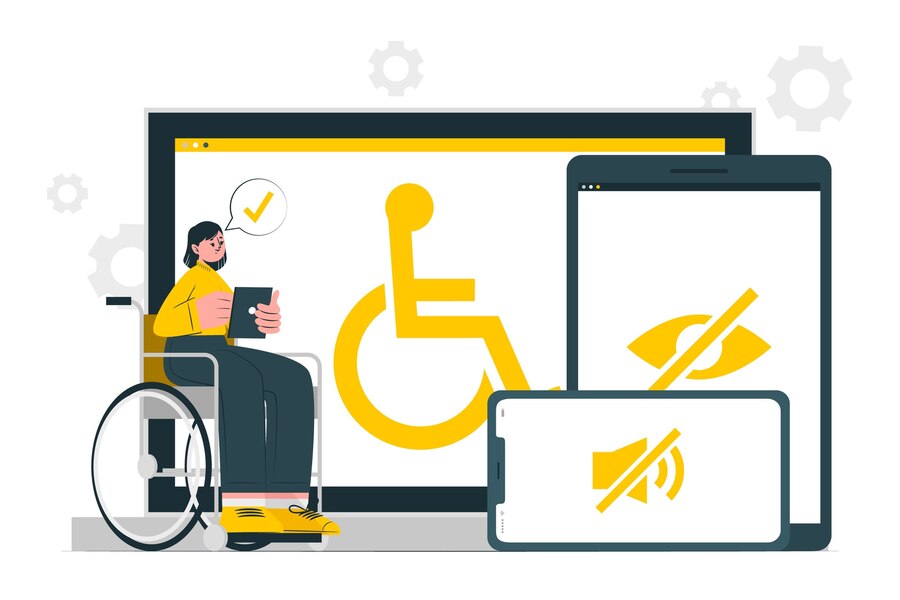As the digital market changes fast, e-commerce websites need to be accessible to everyone. This article explores the common problems that make eCommerce websites hard to use for people with disabilities, such as using colors to communicate information, having low contrast between text and background, not allowing keyboard-only navigation, and having online forms that are not accessible. By reading this article, you will learn what web accessibility means and how to make your eCommerce website more accessible, following the rules of the ADA and the WCAG standards.
What is web accessibility?
Web accessibility means that people with different kinds of disabilities can use websites and online resources effectively. It is based on the idea that everyone should have equal access to information and functionality on the web, which is a key part of inclusive web design. Some various laws and standards support this concept, such as the WCAG standard and the ADA Title III, which require website content to be perceivable, operable, understandable, and robust.
The WCAG, created by the W3C, gives web developers guidance on how to make web content more accessible for all users, including those with disabilities. The WCAG is the global standard for web accessibility and is often used as a reference in legal regulations for website accessibility.
In the US, ADA Title III says that public places, which include websites, must be accessible to people with disabilities. The ADA does not mention websites specifically, but courts and lawsuits have decided that websites are covered by it. This means that businesses with inaccessible websites could face legal problems, which shows why ADA compliance is important in web design. Besides this law, the US also has other laws that affect web accessibility, such as Section 508 of the Rehabilitation Act and the Colorado Accessibility Law, HB 21-1110. You can learn more about the web accessibility situation in the US by reading our related blog post.
WCAG and ADA Title III together explain the legal and practical sides of web accessibility, which means that websites and online resources should be inclusive and easy to use for all users. By following these standards, website owners not only meet the legal requirements but also make the internet more inclusive and fair, improving the user experience for a wide range of people. This is very important in today’s world, where the Internet is a vital part of everyday life, business, education, and social interaction.
Why is web accessibility important for e-commerce websites?
Web accessibility makes your website more usable for people with disabilities, which increases your potential customers. eCommerce accessibility compliance is a smart business choice that has many advantages, such as reaching more markets, creating a better user experience, boosting SEO, and building a positive brand image. Also, adding accessibility features to your website, such as easy navigation and readable text, improves the user experience and loyalty for everyone, not just those with disabilities.
Here are a few considerations:
- Inclusivity and Broader Market Reach: Web accessibility ensures that your eCommerce site is usable by people with a wide range of disabilities, including visual, auditory, physical, speech, cognitive, language, learning, and neurological disabilities. By accommodating these diverse needs, you’re not only practicing inclusivity but also tapping into a wider market of potential customers. For instance, optimizing your website for screen readers not only aids visually impaired users but also benefits those who prefer auditory learning.
- Accessibility features not only help people with disabilities but also make websites better for everyone. Things like easy-to-use menus and clear text are good for all users. Adding these features can make customers happier and more loyal.
- Legal Compliance and Risk Mitigation: Various countries have laws and regulations requiring digital accessibility (such as the Americans with Disabilities Act in the U.S. and the Accessibility for Ontarians with Disabilities Act in Canada). Non-compliance can lead to legal repercussions, including costly lawsuits and reputational damage. By prioritizing accessibility, eCommerce businesses can mitigate these risks.
- SEO Benefits: Many web accessibility best practices, such as providing alternative text for images and ensuring content is organized and tagged correctly, overlap with search engine optimization (SEO) best practices. This can improve your site’s search engine ranking, making it more visible to potential customers.
- Social Responsibility and Brand Image: Demonstrating a commitment to accessibility reflects positively on your brand’s image. It shows corporate social responsibility, which can strengthen your brand reputation and appeal to socially conscious consumers.
- Improved Conversion Rates: An accessible website can lead to a better user experience, which in turn can increase the likelihood of conversions. When users can navigate your website easily and find what they need without obstacles, they are more likely to complete a purchase.
- Future-Proofing and Technological Advancement: The digital landscape is constantly evolving, and web accessibility standards are becoming increasingly important. By making your eCommerce website accessible now, you’re future-proofing your business against upcoming technological changes and ensuring that your site remains usable and relevant.
- Reflecting Diversity and Inclusion Values: In an era where consumers are more aware and appreciative of diversity and inclusion, having an accessible website is a powerful statement. It shows that your business cares about all its customers and is committed to serving a diverse population.
Read also:
What is ADA compliance?
The ADA is a broad civil rights law that was passed in the US in 1990. This important law aims to give equal opportunities and rights to people with disabilities. The main idea of the ADA is to create a welcoming and accessible environment for everyone, no matter their physical or mental abilities.
What does ADA compliance mean for e-commerce?
ADA compliance for eCommerce, under Title III, is important because websites are seen as public places. eCommerce ADA compliance means making websites that people with different disabilities can use and navigate, with accessible design features such as screen readers, keyboard-only navigation, and transcripts for audio/video content.
Here are some key considerations:
- Website Accessibility: E-commerce websites must be accessible to people with a variety of disabilities. This includes ensuring that websites are navigable and usable for people with visual, auditory, motor, or cognitive disabilities.
- Accessible Design: This involves designing websites that can be accessed using screen readers, can be navigated without a mouse (using keyboard-only navigation), and provide captions or transcripts for audio and video content.
- Consistent Evolution: As technology evolves, so do the standards for ADA compliance in the digital sphere. Staying informed and regularly updating your website to be inclusive is not just about compliance, but also about ensuring a positive experience for all users.
- Legal Implications: Non-compliance with ADA standards can lead to legal challenges. Ensuring ADA compliance is not only ethically important but also safeguards against potential litigation.
What is the WCAG?
The WCAG or Web Content Accessibility Guidelines are a set of best practices for making the Internet more inclusive and user-friendly for everyone, especially for people with disabilities. The W3C or World Wide Web Consortium, through its WAI or Web Accessibility Initiative, developed these guidelines as the global standard for web accessibility. The main goal of the WCAG is to establish a common criterion for web content accessibility that can serve the diverse needs of individuals, organizations, and governments around the world. These guidelines aim to make web content more adaptable and usable for people with various types of disabilities, such as hearing, learning, mental, physical, speech, and vision impairments.
What are the four principles of WCAG?
WCAG is based on four foundational principles, often summarized as POUR, to ensure web content is:
- Perceivable: Information and user interface components must be presented in ways that users can perceive, meaning that they can’t be invisible to all of their senses.
- Operable: User interface components and navigation must be operable, meaning that users must be able to operate the interface. This includes accommodating various devices like keyboards and assistive technologies.
- Understandable: Information and the operation of the user interface must be understandable, ensuring that content is clear and limits confusion.
- Robust: Content must be robust enough to be interpreted reliably by a wide variety of user agents, including assistive technologies.
Are there different versions of the WCAG standard?
The Web Content Accessibility Guidelines (WCAG) are a collection of recommendations for making the Internet more accessible and welcoming for everyone, especially for people with disabilities. The World Wide Web Consortium (W3C), through its Web Accessibility Initiative (WAI), created these guidelines as the global standard for web accessibility. The main purpose of the WCAG is to provide a universal criterion for web content accessibility that can suit the various needs of individuals, organizations, and governments around the world. These guidelines aim to make web content more compatible and user-friendly for people with different kinds of disabilities, such as hearing, learning, mental, physical, speech, and vision impairments.
The WCAG standard has gone through several versions to keep up with the changes in technology and the better understanding of accessibility needs:
- WCAG 1.0: The first version, launched in 1999, offered an initial framework for web accessibility.
- WCAG 2.0: Released in 2008, it presented more detailed guidelines, focusing on technology independence and measurable criteria.
- WCAG 2.1: Published in 2018, this version included more guidelines, especially addressing mobile accessibility, people with low vision, and people with cognitive and learning disabilities.
- WCAG 2.2 and Beyond: As web technology continues to advance, so do the guidelines. Future versions are expected to address new needs and technologies. We have discussed this in a related blog post on what to expect next in web accessibility compliance.
Following WCAG is the best way to ensure a website meets the required accessibility standards. This is important for several reasons:
Legal Compliance: In many regions, following WCAG guidelines is a legal obligation to meet accessibility laws, such as the ADA in the United States.
Wider Audience Reach: Accessible websites can reach a larger audience, including the estimated one billion people worldwide with disabilities.
Enhanced Usability: Accessibility features often enhance the overall user experience for all users, not just those with disabilities.
Social Responsibility: Ensuring website accessibility aligns with social responsibility and fosters inclusivity.
WCAG serves as a comprehensive guide for creating web content that is accessible to all users, regardless of their abilities or disabilities. By following these guidelines, website owners and developers can create inclusive digital environments that serve a diverse audience and comply with legal standards.
How does the WCAG apply to e-commerce?
The WCAG or Web Content Accessibility Guidelines are essential for making eCommerce more accessible and user-friendly for everyone. They provide eCommerce website accessibility, with guidelines for designing websites that are accessible, operable, and mobile-friendly for people with different kinds of disabilities. eCommerce sites need to think about the whole shopping experience, from navigating the site to completing the purchase and offer clear product accessibility information.
A few key considerations would be as follows:
Here are a few considerations regarding the way the WCAG applies to e-commerce:
- Accessible Website Design: E-commerce sites must be designed and developed in a way that all content is accessible. This includes text, images, navigation, forms, and video or audio content. For instance, images should have alternative text (alt-text) for screen readers, videos should have captions, and website navigation should be achievable through keyboard-only inputs.
- User Experience for All: WCAG guidelines ensure that the e-commerce website is operable for people with various disabilities. This includes easy navigation for screen reader users, sufficient contrast ratios for users with visual impairments, and simple, intuitive interfaces for users with cognitive disabilities.
- Mobile Accessibility: Given the increasing use of mobile devices for online shopping, WCAG’s focus on mobile accessibility is crucial. E-commerce sites must ensure that their mobile versions or apps adhere to accessibility standards, providing features like responsive design and accessible touch targets.
- Checkout Process: The checkout process in e-commerce is a critical component where accessibility can’t be overlooked. This includes making forms accessible, providing clear instructions, and error messages that are easy to understand and correct, and ensuring that all payment options and processes are accessible.
- Product Accessibility Information: Providing detailed accessibility information about products can be beneficial. For example, descriptions for assistive technologies used by visually impaired customers or compatibility features for hearing aid devices.
How to implement the WCAG in e-commerce?
To make eCommerce more accessible, frequently check your site for WCAG compliance, train your team on web accessibility, and include users with disabilities in testing stages. This makes sure that your eCommerce site is always up to date with the current accessibility standards.
What are some accessibility challenges that e-commerce websites face?
eCommerce websites have to deal with the trade-off between visual attractiveness and functional accessibility. Accessibility can be affected by complicated navigation and dynamic content like live updates and interactive carts, which highlights the importance of thoughtful design and development.
Read also:
How to boost your ecommerce sales with these 30 marketing tactics
20 tips for e-commerce website accessibility
With the rapid growth of digital technology, making your e-commerce website inclusive and user-friendly for everyone is not only an ethical duty but also a smart business strategy. As we enter 2024, here are 20 essential suggestions to create an online store that everyone can enjoy:
- Understand Web Accessibility Standards: Familiarize yourself with WCAG and ADA guidelines.
- User-Friendly Navigation Design: Implement breadcrumb trails and clear menu labels.
- Accessible Website Layouts: Use consistent layouts and a grid system.
- Color Contrast and Visual Design: Ensure high contrast and use tools like WebAIM’s Color Contrast Checker.
- Text Readability and Font Usage: Choose readable fonts and allow text resizing.
- Keyboard Navigation: Ensure all site functions are keyboard-accessible.
- Screen Reader Compatibility: Use proper HTML semantics and ARIA labels.
- Alt Text for Images and Media: Provide descriptive alt text for all visuals.
- Video and Multimedia Accessibility: Include captions and transcripts for video content.
- Accessible Forms and Input Fields: Design user-friendly forms with clear labels.
- Error Identification: Provide clear, helpful error messages.
- Consistent, Predictable User Experience: Maintain consistent layouts and functionality.
- Mobile and Responsive Design Accessibility: Ensure your site is accessible on various devices.
- Accessibility Testing Tools: Use tools like Axe and Lighthouse for regular audits.
- Voice Command and Speech Recognition Integration: Adapt for compatibility with virtual assistants.
- Customizable User Interface: Offer options for adjusting color schemes and font sizes.
- Feedback and User Testing: Engage with users with disabilities for real feedback.
- Accessibility Training: Educate your team on the importance of accessibility.
- Stay Updated on Compliance and Policies: Keep informed about legal requirements.
- Stay Updated on Accessibility Trends: Follow developments in accessibility technology.
What happens if my e-commerce website is not web accessible?
Failing to meet web accessibility standards can have several negative consequences for your business: losing potential customers with disabilities, facing legal actions under laws like ADA, and hurting your site’s SEO. It’s vital to see eCommerce accessibility compliance as a smart business move that expands your market and shows your brand’s commitment to inclusivity.
Let’s examine each of these in more detail.
First of all, you risk losing a large portion of potential customers who have disabilities. This exclusion not only leads to a direct loss of potential income but also undermines the inclusivity of your digital presence. People with disabilities are a significant market segment, and by not meeting their needs, your business fails to connect with and serve this audience.
Furthermore, the absence of accessibility can result in severe legal consequences. Under laws such as the Americans with Disabilities Act (ADA), businesses are obligated to provide equal access to their services, which includes digital platforms like e-commerce sites. Violating these regulations can result in lawsuits and hefty fines, as evidenced by the rising number of legal cases related to digital accessibility. These legal issues not only pose financial threats but can also harm your brand’s image, affecting customer loyalty and trust.
Additionally, an inaccessible website can adversely affect your site’s Search Engine Optimization (SEO). Search engines prefer websites that offer an accessible experience, as it matches their goal of providing useful and user-friendly content. Therefore, lacking in web accessibility could potentially lower your site’s position in search results, decreasing visibility and traffic.
In summary, ensuring web accessibility is not only a legal duty but also a wise business choice. It broadens your market, improves customer experience, and demonstrates your brand’s values of inclusivity and equal access, all while protecting against legal and reputational risks.





Leave a Reply